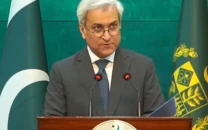China’s rise and the shaping of a new Asian order
China’s economic rise led by an assertive leadership have led to the reenactment of the Cold War, Asia-style

The writer is a former caretaker finance minister and served as vice-president
at the World Bank
The Chinese economy has grown rapidly since the late 1970s, when it opened to the outside world. The economy in 2015 is 32 times larger than its size in 1979, when, after the death of Chairman Mao Zedong three years earlier, Beijing began to move away from communism with Chinese characteristics to a system that allowed more space to private entrepreneurs and private enterprise. “It is glorious to be rich,” declared Deng Xiaoping, who succeeded Mao as the great supreme leader of the Communist Party and the Chinese state. The new leader not only introduced a new style of economic governance. He also put in place a new system of political management. This had two important features: the unchallenged dominance of the party along with a systematic renewal of the party leadership every 10 years.
Deng withdrew from leadership allowing the first of three sets of leaders to succeed him. He reappeared briefly to guide the country back to what he regarded as normalcy. He strongly believed that the trauma of Tiananmen Square had to be dealt with firm resolve. In 1993, Jiang Zemin was given the reins of power and he governed the country along with Prime Minister Zhu Rongji. In 2003, President Hu Jintao and Prime Minister Wen Jiabao succeeded the Jiang-Zhu leadership duo. The pair gave way in 2013 to the leadership of President Xi Jinping and Prime Minister Li Keqiang. Each set of leaders left its mark on the Chinese economy, its politics and its place in the world.
Xi took over the reins of government when, according to one way of estimating the size of national income, China was declared to be the world’s largest economy. In October 2014, the International Monetary Fund (IMF) used the purchasing power parity method to calculate the size of large economies. According to its arithmetic, China overtook the US and became the world’s largest economy some time in 2014.
China moved into the first position at a difficult time for the established economies in the West. Buffeted by the Great Recession of 2008-09 and by political developments in the Middle East, both the US and Europe seemed to have weakened not only in economic terms. They had also lost the sense of direction they were taking in the rapidly reshaping global order. That notwithstanding, Washington — both executive and legislative branches of the government — developed strategies aimed at containing China. A number of approaches were developed with Beijing responding to each one of them in its own way.
The Obama Administration wanted to increase China’s share in the IMF ‘quotas’ and the share capital of the World Bank. But that required the authorisation of Congress, which was not forthcoming. Beijing responded by establishing its own development bank, the Asian Infrastructure Investment Bank (AIIB). The Obama Administration worked hard to persuade its European and Asian allies not to seek membership in the AIIB. Instead, most European and Asian states rushed in and became members of the new institution. The Obama Administration also worked to get 11 Pacific Rim states to join it in a trade agreement that would focus on the regulatory aspect of international trade. China was kept out of the Trans-Pacific Partnership. It reacted by setting up its own regional trade arrangement.
Perhaps, the most troubling aspect of this tit-for-tat approach to the creation of a new Asian political order is in the military area. The Chinese have concluded an agreement with Pakistan that will give it access to the deep-water port of Gwadar on the Balochistan coast. This will provide the Chinese Navy with access to a port on the western side of the Asian continent. Watching this development with some anxiety, three large Asian powers responded by moving towards a trilateral arrangement. Senior officials representing Australia, India and Japan met in New Delhi in June to explore how they could work together. In the words of Akitaka Saiki, vice foreign minister of Japan, “the three nations are on the same page with respect to China’s aggressive behaviour”. According to an assessment by David Lang, an analyst at the Australian Strategic Policy Institute, “that the three countries have now reconvened security-focused discussions (with potential spin-off naval activities) speak not only to a shared understanding of China’s rise and the challenges of regional security, but also to their willingness to play a greater role in Asia-Pacific security matters”.
China’s economic rise and the fact that it is now led by an assertive leadership have led to the reenactment of the Cold War, Asia-style. This is unfortunate. The much- anticipated economic rise, not only of China but the rest of Asia as well, was supposed to lead the continent to carve a place for itself in the new global order. For that to happen, large Asian nations were expected to work in unison, not become rivals in their search for prominence.
Published in The Express Tribune, July 13th, 2015.
Like Opinion & Editorial on Facebook, follow @ETOpEd on Twitter to receive all updates on all our daily pieces.
















COMMENTS
Comments are moderated and generally will be posted if they are on-topic and not abusive.
For more information, please see our Comments FAQ